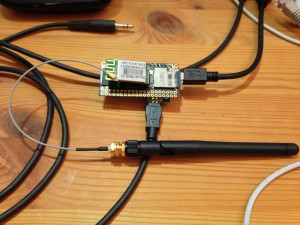This weekend, I received my ACME Arietta G25 Atmel ARM board, and tried to get it going with my Mac. I ordered the “plain” version with 128 MB RAM, as well as one with 256MB RAM, as well as Wifi boards and the DPI debug board.
After soldering in the necessary posts, I attached the DPI board and verified that my Mac has the right FT232 driver to access the console, no problems here.
I then fired up by Ubuntu VirtualBox machine and followed the instructions to build the Micro-SD-Card image. I then proceeded to boot successfully from the card.

Through the console, I could get the Wifi card going; since I wanted to have support for more than a single network, I extended the configuration through wpa_supplicant.conf.
ACME has configured a Gadget driver to supply an Ethernet interface through the host port on the Arietta; in ACMEs configuration, this is set to offer both RNDIS and CDC EEM modes. Unfortunately, Mac OS X 10.9 doesn’t support either.
After some more reading, I decided to build my own kernel and modules. To get a Mac-compatible setup for the USB Gadget driver, run menuconfig, and navigate to
- Device Drivers
- USB support
- USB Gadget Support (at the very bottom of the list)
For Mac compatibility, de-select the RNDIS support and the Ethernet Emulation Model (EEM) support under Ethernet Gadget.
I also chose to enable the Serial Gadget and the CDC Composite De
vice (Ethernet and ACM).
After building the kernel and replacing the files on the SD Card, I changed the module load line in /etc/network/interfaces to load the g_cdc module instead of the g_ether module, and added an entry in /etc/inittab for /dev/ttyGS0 to also have a console through the host port.
